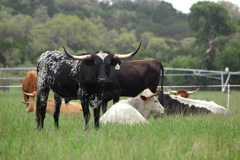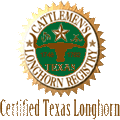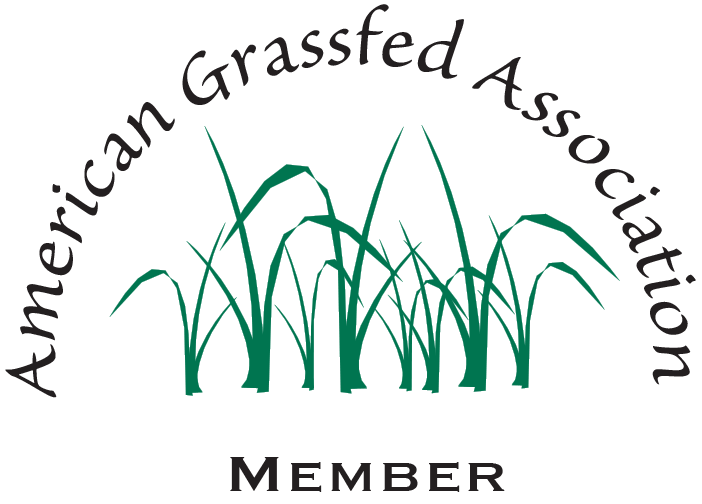3 oz. Cooked
Serving of: |
Beef, Composite Retail Cuts* |
Pork, Composite Retail Cuts* |
Lamb, Domestic Retail Cuts* |
Veal, Composite Retail Cuts* |
Buffalo |
Chicken, Broilers or Fryers, Meat & Skin |
Turkey, All Classes, Meat & Skin> |
Salmon, Sockeye |
Texas Longhorn Beef** |
| Calories (kcal) |
259 |
232 |
250 |
196 |
111 |
203 |
177 |
183 |
142 |
| Protein (g) |
22.0 |
23.4 |
20.8 |
25.5 |
22.8 |
23.2 |
23.8 |
23.2 |
27.0 |
| Fat (g) |
18.3 |
14.6 |
17.8 |
9.6 |
1.5 |
11.6 |
8.3 |
9.3 |
3.7 |
| Cholesterol (mg) |
74.8 |
77.3 |
82.4 |
96.9 |
51.8 |
74.8 |
69.7 |
74 |
31.0 |
|
SOURCE: USDA National Nutrient Database For Standard Reference, Release 16, 2003. separable lean and fat Quanta Lab, San Antonio - nutritional analysis, July 2003. Average of 3 oz. boneless eye of round steak, cooked, and 3 oz. Boneless New York strip steak, cooked.
|
 Grassfed beef contains higher levels of Omega-3 Fatty Acid, Conjugated Linoleic Acid (CLA), Beta-Carotene and Vitamin E, than their grain-fed counterparts. All of these nutrients are believed to benefit the body’s defenses against cancer and cardiovascular disease. Grassfed beef contains higher levels of Omega-3 Fatty Acid, Conjugated Linoleic Acid (CLA), Beta-Carotene and Vitamin E, than their grain-fed counterparts. All of these nutrients are believed to benefit the body’s defenses against cancer and cardiovascular disease.
Omega-3 Fatty Acids “good fats” are essential for brain function and help prevent mental disorders. Your cardiovascular system is equally dependant on Omega-3’s to regulate blood pressure and heart rhythms. Omega-3’s are believed to reduce the amount of linoleic acid that tumors withdraw from the blood stream, denying them a much-needed nutrient through competitive uptake. Omega-3’s also compete with Omega-6’s for enzymes needed for creation of cancer promoting metabolites, make cancer cells more vulnerable to free-radical attack and promote self-destruction of cancer cells. Omega-3’s are found in plant leaves (60% is alpha-linolenic acid “LNA”). Omega-6’s are present in plant seeds and are high in linoleic acid. High amounts of Omega-6’s have been linked with higher risk of obesity, diabetes, cancer and immune disorders such as asthma and arthritis. Feeding cattle grain diminishes the supply of Omega-3 Fatty Acids in their muscle tissue and replaces them with an overabundance of Omega-6 Fatty Acids.
Conjugated linoleic acid and alpha-linolenic acid are “good,” Linoleic acid is “bad” in overabundance. Studies suggest that a diet containing roughly equal amounts of Omega-3 and Omega-6 Essential Fatty Acids lowers the risk of cancer, cardiovascular disease, autoimmune disorders, allergies, obesity, diabetes, dementia, and various other mental disorders. “Good for you" oils include cod liver oil; fish oil from wild-caught fish in mercury, PCB and lead-free waters; flaxseed oil; olive oil; coconut oil; palm kernel oil; butter fat from grassfed animals; duck and goose fat from wild or pastured birds; beef and mutton tallow from pastured animals and lard from pastured pork.
Oils high in Omega-6 that should be used in limited amounts include: peanut oil, sesame oil, safflower oil, corn oil, sunflower oil and cottonseed oil.
 Oils to be avoided include: Oils to be avoided include:
- Canola oil because it contains erucic acid that in some circumstances is associated with fibrotic heart lesions and it creates a deficiency of Vitamin E.
- Soybean oil because it contains high levels of phytic acid which reduces assimilation of calcium, magnesium, copper, iron and zinc. This can cause growth problems in children. Soy also contains trypsin inhibitors that interfere with protein digestion and may cause pancreatic disorders. Soy also contains phytoestrogens that disrupt endocrine function and have potential to cause infertility and promote breast cancer in adult women. They also can cause hypothyroidism in adults. Infant consumption of soy formula has been linked to autoimmune thyroid disease. Soy increases the body's need for Vitamins B12 and D and processing of soy protein results in the formation of toxic lysinoalanine and highly carcinogenic nitrosamines. Free glutamic acid or MSG, a neurotoxin, is formed during soy food processing and these foods also contain high levels of aluminum which is toxic to the nervous system and kidneys.
- Polyunsaturated oils and oils that have been hydrogenated.
CLA is known for its antioxidant qualities. Research shows promise that CLA reduces tumor growth and risk of cancer, obesity, diabetes, and a number of immune disorders. CLA builds in muscle tissue of grassfed animals and is replaced with linoleic acid, a preferred cancer cell food, when animals consume grain.
Beta-Carotene is an antioxidant linked to lower incidence of cancer and cardiovascular disease. It is evident in the yellow color of fat in grassfed animals.
Vitamin E is an antioxidant that protects healthy cells from free radical damage, aiding the body’s defense against cancer and cardiovascular disease.
Sources of information:
Nourishing Traditions by Sally Fallon http://www.westonaprice.org/
Omega Diet by Jo Robinson http://www.eatwild.com/
 


Additional Information:
20 minute video on the state of our food supply from the perspective of
some of today's greatest minds in sustainable agriculture
California State University, Chico College of Agriculture and University of California Cooperative Extension - https://www.csuchico.edu/regenerativeagriculture/ra101-section/managed-grazing.shtml
Greener Pastures - How grass-fed beef and milk contribute to healthy eating, Kate Clancy, Union of Concerned Scientists
Article about howEating Local reduces climate change.
Grassfed Carbon Footprint
|



